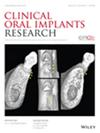修复出牙角度对种植体周围软硬组织影响的临床前研究
IF 5.3
1区 医学
Q1 DENTISTRY, ORAL SURGERY & MEDICINE
引用次数: 0
摘要
目的探讨种植体周围软硬组织在种植体出现角度和夹板形态上的影响。材料与方法将30颗种植体植入5只beagle犬的下颌前磨牙(P2、P3、P4)。在裂口设计中,每只动物在下颌骨的每侧均接受窄(NE)(出牙角= 30°)和宽(WE)(出牙角= 60°)基牙。植入物随后被夹板固定。在修复后0、4、12和24周拍摄x线图像。然后收集活检样本进行组织形态学分析和圆偏振光检查。所有的分析都是基于夹板位置进行的:末端种植体的中端或远端,末端种植体的夹板区,或中间种植体的夹板区。结果影像学检查显示WE组骨重塑更为明显。在组织形态学分析中,WE组种植体肩关节到牙槽骨嵴的垂直距离和浸润结缔组织面积均明显增大。相反,NE组表现出更长的结缔组织附着。圆偏振光分析显示,WE组种植体周围上皮以及夹板区口腔上皮中胶原纤维的面积分数显著降低。结论假体出现角度过宽会破坏结缔组织附着,阻碍软组织密封的形成,可能导致骨重塑明显。本文章由计算机程序翻译,如有差异,请以英文原文为准。
The Effect of Restorative Emergence Angle on Soft and Hard Tissue Around Splinted Implants: A Preclinical Study
ObjectiveTo investigate the impact of the restorative emergence angle and splinting configurations on peri‐implant soft and hard tissues.Materials and MethodsThirty implants were placed in the mandibular premolars (P2, P3, P4) of five beagle dogs. In a split‐mouth design, each animal received both narrow (NE) (emergence angle = 30°) and wide (WE) (emergence angle = 60°) abutments on each side of the mandible. The implants were subsequently splinted. Radiographic images were captured at 0, 4, 12, and 24 weeks post‐restoration. Biopsy samples were then collected for histomorphometric analysis and circularly polarized light examination. All analyses were performed based on the splinted positions: either the mesial or distal end of the terminal implant, the splinted zone of the terminal implant, or the splinted zone of the middle implant.ResultsRadiographic evaluation showed more pronounced bone remodeling in the WE group. In histomorphometric analysis, both the vertical distance from the implant shoulder to the alveolar bone crest and the infiltrated connective tissue areas were significantly larger in the WE group. Conversely, the NE group exhibited a longer connective tissue attachment. Analysis using circularly polarized light indicated a significantly reduced area fraction of collagen fibers in the peri‐implant epithelium of the WE group, as well as in the oral epithelium of the splinted zone.ConclusionA wide emergence angle of implant prostheses can compromise connective tissue attachment, hinder the formation of an adequate soft tissue seal, and potentially lead to marked bone remodeling.
求助全文
通过发布文献求助,成功后即可免费获取论文全文。
去求助
来源期刊

Clinical Oral Implants Research
医学-工程:生物医学
CiteScore
7.70
自引率
11.60%
发文量
149
审稿时长
3 months
期刊介绍:
Clinical Oral Implants Research conveys scientific progress in the field of implant dentistry and its related areas to clinicians, teachers and researchers concerned with the application of this information for the benefit of patients in need of oral implants. The journal addresses itself to clinicians, general practitioners, periodontists, oral and maxillofacial surgeons and prosthodontists, as well as to teachers, academicians and scholars involved in the education of professionals and in the scientific promotion of the field of implant dentistry.
 求助内容:
求助内容: 应助结果提醒方式:
应助结果提醒方式:


